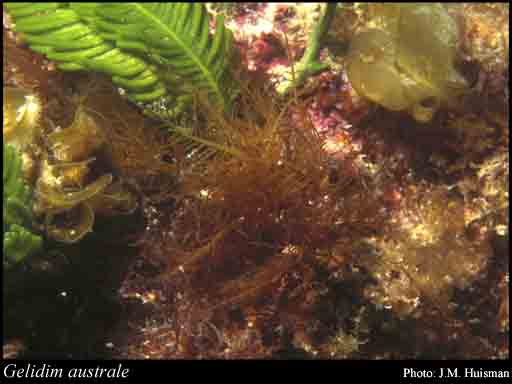- Reference
- Acta Univ.Lund. 30 (1872)
- Conservation Code
- Not threatened
- Naturalised Status
- Native to Western Australia
- Name Status
- Current

Scientific Description
Habit and structure. Thallus medium to dark red-brown, cartilaginous, forming erect, densely branched tufts (5–)10–25(–30) cm high, with several to numerous bipinnate axes. Axes tapering only slightly from base to upper parts, subterete to compressed, relatively straight, 0.7–2 mm broad near the base, 400–700(–1000) µm broad above, distichously branched every (0.5–)1–3 mm from base to near apices, rarely with unbranched ends 0.5–2 cm long, sometimes partly denuded below; laterals usually crowded and displaced from being strictly distichous. Pinnae 2–8(–12) cm long and 200–400 µm broad, subterete to slightly compressed, B/T 1.5–2. Pinnules every (0.5–)1–3 mm on pinnae, irregularly alternate, 2–5 cm long and 100–200 µm broad. Holdfast 2–10 mm across, of slender haptera 200–300 µm in diameter, arising from the base of the axis, and with short stolons; epilithic. Structure. Cortex 2–4 cells thick, outer cells in surface view in slight longitudinal rows with the protoplast 3–5(–6) µm across, wall relatively thin, inner cells becoming radially elongate; medulla of elongate cells with hyphae; rhizines profuse in inner cortex, rare in central medulla.
Reproduction. Fertile ramuli all around or (usually) tending to be on two sides of the pinnules, (0.4–)1–2.5(–3) mm long, 60–160(–200) µm thick, subterete to slightly compressed. Cystocarps single per ramulus, usually just in the basal half with the ramulus tapering above, 200–500 µm across, bilocular with a distinct ostiole on each side; carposporangia clavate, 10–25 µm in diameter; elongate arachnoid cells and nutritive cell chains present. Spermatangial sori covering short, basally sterile, ramuli which become branched subdistichously or proliferous, 1–2 mm long and 200–300 µm in diameter, with the outer cortical cells replaced by elongate spermatangial initials from which subspherical spermatangia 1–2 µm in diameter are cut off terminally. Stichidia clavate to tapering above, with a short to medium stalk, the fertile region 300–800(–1200) µm long, 150–250 µm broad. Tetrasporangia derived from cortical cells, mixed, lying in the outer medulla all around the stichidia, ovoid, irregularly or regularly decussately or cruciately divided, 30–45 µm in diameter.
Distribution. W. Aust., to Walkerville, Vic. [possibly to southern Qld.] and around Tas.
[After Womersley, Mar. Benthic Fl. Southern Australia IIIA: 132 (1994)]
Distribution
- IMCRA Regions
- Leeuwin-Naturaliste.
- Local Government Areas (LGAs)
- Cockburn.